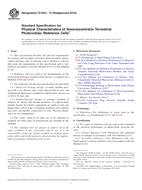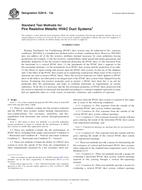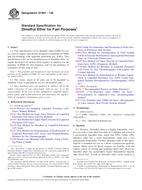1.1 This guide covers procedures for measuring the bioaccumulation of sediment-associated contaminants by infaunal invertebrates. Marine, estuarine, and freshwater sediments are a major sink for chemicals that sorb preferentially to particles, such as organic compounds with high octanol-water-partitioning coefficients (Kow) (for example, polychlorinated biphenyls (PCBs) and dichlorodiphenyltrichloroethane (DDT)) and many metals. The accumulation of chemicals into whole or bedded sediments (that is, consolidated rather than suspended sediments) reduces their direct bioavailability to pelagic organisms but increases the exposure of benthic organisms. Feeding of pelagic organisms on benthic prey can reintroduce sediment-associated contaminants into pelagic food webs. The bioaccumulation of sediment-associated contaminants by sediment-dwelling organisms can therefore result in ecological impacts on benthic and pelagic communities and human health from the consumption of contaminated shellfish or pelagic fish.
1.2 Methods of measuring bioaccumulation by infaunal organisms from marine, estuarine, and freshwater sediments containing organic or metal contaminates will be discussed. The procedures are designed to generate quantitative estimates of steady-state tissue residues because data from bioaccumulation tests are often used in ecological or human health risk assessments. Eighty percent of steady-state is used as the general criterion. Because the results from a single or few species are often extrapolated to other species, the procedures are designed to maximize exposure to sediment-associated contaminants so that residues in untested species are not underestimated systematically. A 28-day exposure with sediment-ingesting invertebrates and no supplemental food is recommended as the standard single sampling procedure. Procedures for long-term and kinetic tests are provided for use when 80 % of steady-state will not be obtained within 28 days or when more precise estimates of steady-state tissue residues are required. The procedures are adaptable to shorter exposures and different feeding types. Exposures shorter than 28 days may be used to identify which compounds are bioavailable (that is, bioaccumulation potential) or for testing species that do not live for 28 days in the sediment (for example, certain Chironomus). Non-sediment-ingestors or species requiring supplementary food may be used if the goal is to determine uptake in these particular species because of their importance in ecological or human health risk assessments. However, the results from such species should not be extrapolated to other species.
1.3 Standard test methods are still under development, and much of this guide is based on techniques used in successful studies and expert opinion rather than experimental comparisons of different techniques. Also, relatively few marine/estuarine (for example, Nereis and Macoma), freshwater (for example, Diporeia and Lumbriculus variegatus) species, and primarily neutral organic compounds provide a substantial portion of the basis for the guide. Nonetheless, sufficient progress has been made in conducting experiments and understanding the factors regulating sediment bioavailability to establish general guidelines for sediment bioaccumulation tests.
Product Details
- Published:
- 04/01/2010
- Number of Pages:
- 57
- File Size:
- 1 file , 730 KB
- Redline File Size:
- 2 files , 1.4 MB


